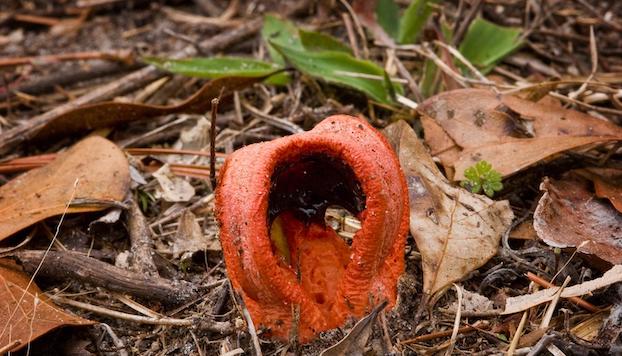Stinkhorn Mushrooms: you smell them before you see them
Published 3:58 pm Friday, March 8, 2024

- The Column Stinkhorn (Clathrus columnatus). (John Ghent, Bugwood.org)
|
Getting your Trinity Audio player ready...
|
The caller explained that they had these alien-looking, pink things that resembled the pi sign. I said, “The what sign, the peace sign?” They said you know, the pi sign, like math. Then it clicked for me, “Oh…pi, like 3.14”
I have to say, I was intrigued and quite puzzled at the same time. What in the wide world of sports could this be? My next step was to ask for pictures and then of course I followed up with a home visit. By the time I got there, everything had dried up but there were these little dragon egg-looking structures left behind.
There was no doubt this was some type of mushroom but what? These particular mushrooms resembled the pi sign having a top and two orangish-pinkish legs with what looked like octopus suction cups on them. This was the tell-tale sign that these were octopus or column stinkhorns (Clathrus columnatus).
So, what are mushrooms anyway? They are the fruiting bodies of some types of fungus. Just like the fruit we love so much containing seeds; mushrooms are reproductive structures that contain the spores. There are multiple types of stinkhorns but they all have one thing in common-they stink. The smell is like that of rotting flesh. The reason they stink is to attract flies that then get covered in a wet slime, containing spores (like seeds) of the fungus, and disperse them everywhere they go. Most fungal spores are dispersed through wind so these are actually a little special.
There are several types of stinkhorns that we may run across in our lawns and mulch beds. In addition to the column stinkhorn, there is another that will be pink to orange in color with a brown cap. However, the cap on these is not distinct like most mushrooms because of their spore dispersal mechanism. This is the elegant stinkhorn (Mutinus elegans) although it smells anything but elegant! The last one that I typically see, and I confess, I am no mushroom identification specialist, is Ravenel’s stinkhorn (Phallus ravenelii). This one has a light tan colored stalk with a brown cap that is a bit more pronounced than the elegant stinkhorn.
Most folks report that they will be able to smell them before they see them. The stench is undeniable and can be cause for alarm until they are found. Unfortunately, according to an NC State University Plant, Disease and Insect Clinic blog post, there is no way to get rid of them. Fungicides and disinfectants are of no use against them. Removing the stinkhorns as soon as they are seen will help in removing the smell. They do not harm our plants trees, shrubs, or bedding plants. Turning under or replacing hardwood mulch and then replacing it with composted pine bark mulch may help. However, like most fungi in nature, it is there and just waiting for the right conditions to fruit.
If you are having trouble with growing in your home landscape, call the Extension office at (252)946-0111 or email me at gene_fox@ncsu.edu. Keep an eye on our website or the Beaufort County Master Gardener Facebook page for upcoming classes and events. Mark your calendars for our Totally Tomatoes class April 13 and our Extension Master Gardener Plant Sale April 20. We will have over 1,000 vegetable seedlings for sale from 9-11 a.m. or until supplies last! Until then, Happy Gardening!





